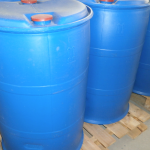CAS NO: 98-51-1
MF: C11H16
S.F.:
Synonyms: Benzene, 1-(1,1-dimethylethyl)-4-methyl ; Toluene, p-tert-butyl-;
P-Tert-Butyltoluene; 1-tert-Butyl-4-Methylbenzene; 1-Methyl-4-tert-butylbenzene; 4-tert-Butyl-1-Methylbenzene;
4-Methyl-tert-butylbenzene;Benzene, 1-methyl-4-tert-butyl-; p-Methyl-tert-butylbenzene; TBT; 4-t-Butyltoluene;
1-(1,1-Dimethylethyl)-4-methyl-benzene; Butyl toluene; Lowinox PTBT; p-t-Butyl toluene
Specifications:
| Appearance | Clear,colorless liquid |
| Content ≥ | 99.5% |
| Flash point | 54°C |
| Molecular weight | 148.25 |
| Refractive index | n 1.4920 |
| Specific gravity | 0.853 |
| Boiling point | 191-193°C |
As a solvent for resins, as a primary intermediate in chemical industry.
Application: P-tert-butylbenzoic acid is an important intermediate in organic synthesis. Its main uses are: used as a modifier for the production of alkyd resin; Used as cutting oil, lubricating oil additive; Used as nucleating agent for polypropylene; Used as a food preservative; Regulator of polyester polymerization; Its barium salt, sodium salt, zinc salt can be used as polyethylene stabilizer; It can also be used as additives of automobile deodorant, outer film of oral medicine, alloy preservative, lubricating additive, polypropylene nucleating agent, polyvinyl chloride heat stabilizer, metal processing cutting fluid, antioxidant, alkyd resin modifier, flux, dye and new sunscreen. It is also used in the production of methyl p-tert-butyl benzoate, widely used in chemical synthesis, cosmetics, fragrance and other industries.
Q: Leakage handling?
Quickly evacuate the leaked contaminated area, isolate the personnel to a safe area and strictly restrict access. Cut off the fire source. It is recommended that emergency personnel wear self-contained positive pressure breathing apparatus and wear protective clothing. Cut off the source of the leak as much as possible. Prevent it from flowing into restricted spaces such as sewers and flood drains.
Small spills: mix with sand, dry lime or soda ash. It can also be brushed with an emulsion made of a non-flammable dispersant, and the lotion is diluted and put into the wastewater system.
Large amount of leakage: Construct dikes or dig pits for containment. Use a pump to transfer it to a tank truck or a special collector, and recycle it or transport it to a waste treatment site for disposal.
Waste disposal method: incineration method
Q: First-aid?
Skin contact: Take off contaminated clothing and rinse the contaminated part with running water.
Eye contact: Lift the eyelids and rinse with running water or saline. Seek medical attention.
Inhalation: Quickly leave the scene to fresh air. Keep airway open. If breathing is difficult, give oxygen. If not breathing, give artificial respiration immediately. Seek medical attention.
Ingestion: Drink plenty of warm water, induce vomiting. Seek medical attention.
Q: Protective measures?
Respiratory system protection: When the concentration in the air is high, a filter gas mask (half mask) should be worn. When emergency rescue or escape, it is recommended to wear air respirators.
Eye Protection: Wear chemical safety goggles.
Body protection: wear anti-poison penetration overalls.
Hand Protection: Wear rubber oil-resistant gloves.
Others: Smoking, eating and drinking are prohibited at the work site. Avoid prolonged repeated exposure.
Q: Storage conditions?
Store in a cool, ventilated warehouse. Keep away from fire and heat sources. It should be stored separately from oxidants and food chemicals, and should not be stored together. Explosion-proof lighting and ventilation facilities are adopted. Prohibit the use of mechanical equipment and tools that are prone to sparks. The storage area should be equipped with leakage emergency treatment equipment and suitable containment materials.
